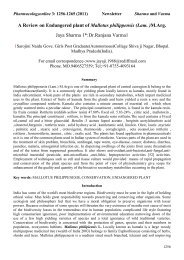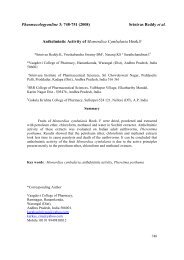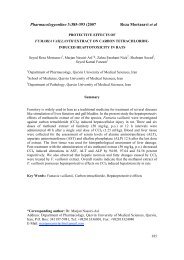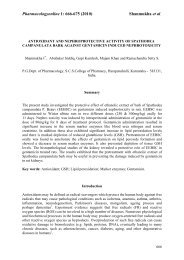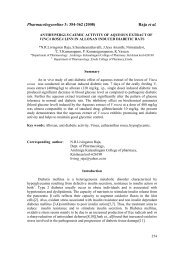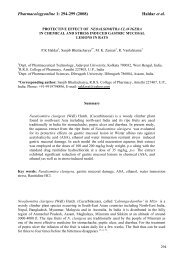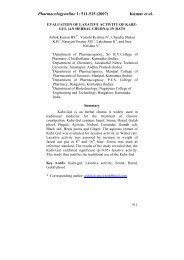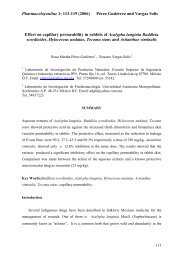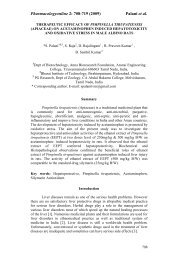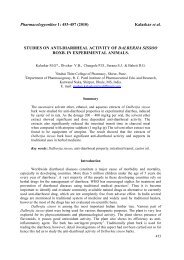Screening of potential antimicrobial activity from Hymenocallis littoralis
Screening of potential antimicrobial activity from Hymenocallis littoralis
Screening of potential antimicrobial activity from Hymenocallis littoralis
Create successful ePaper yourself
Turn your PDF publications into a flip-book with our unique Google optimized e-Paper software.
PhOL<br />
Gram negative bacteria namely Escherichia coli<br />
(hospital strain) , Pseudomonas aeruginosa,<br />
Pseudomonas aeruginosa, Pseudomonas aeruginosa,<br />
Salmonella spp, Proteus mirabilis and Klebsiella<br />
pneumoniae. Two (2) fungal pathogens used were<br />
Candida albicans and Aspergillus niger. These standard<br />
strains were obtained <strong>from</strong> the Microbiology<br />
Laboratory stock, School <strong>of</strong> Biological Sciences,<br />
Universiti Sains Malaysia. All bacteria were maintained<br />
on Nutrient Agar (NA) at 37ºC and fungi on<br />
Potato Dextrose Agar (PDA) at 28 ºC.<br />
Determination <strong>of</strong> Minimum inhibitory concentration<br />
(MIC)<br />
Minimum inhibitory concentration (MIC) was<br />
determined using the broth dilution method 4. The<br />
crude <strong>Hymenocallis</strong> <strong>littoralis</strong> (Jacq.) Salisb extract<br />
was dissolved in methanol to obtain the initial<br />
concentration as 100 mg/ml. Two-fold dilution was<br />
performed <strong>from</strong> the initial test concentration and<br />
each tube was inoculated with 500 ìl suspension<br />
containing 108 CFU/ml <strong>of</strong> bacteria and 104 spore/ml<br />
<strong>of</strong> fungi. The test tube for bacteria was incubated at<br />
37 ºC for 24 hours and at 28 ºC for 48 hours for<br />
fungi. MIC was determined as the lowest concentration<br />
<strong>of</strong> the extract inhibiting the visual growth <strong>of</strong><br />
the test cultures in the tubes based on turbidity.<br />
Results and Discussion<br />
Twelve (12) samples crude extracts <strong>of</strong> different<br />
explants <strong>from</strong> juvenile and flowering stages <strong>from</strong><br />
<strong>Hymenocallis</strong> <strong>littoralis</strong> (Jacq.) Salisb wild plant were<br />
used to screen the <strong>antimicrobial</strong> <strong>activity</strong> namely the<br />
juvenile stage; young leaf, old leaf, stem, bulb and<br />
root and flowering stage; young leaf, old leaf, stem,<br />
bulb, root, flower and flower stalk (Table 1).<br />
Meanwhile, twelve (12) microbes (Table 1) were<br />
used to test all the samples, namely Gram positive<br />
bacteria ( Micrococcus spp, Bacillus subtilis, Bacillus<br />
thuringiensis, Staphylococcus aureus), Gram negative<br />
bacteria (Escherichia coli [normal]), Escherichia coli<br />
(hospital strain) Pseudomonas aeruginosa,<br />
Salmonella spp, Proteus mirabilis, Klebsiella pneumo-<br />
http://pharmacologyonline.silae.it<br />
ISSN: 1827-8620<br />
95 (93 - 98)<br />
niae, and fungal strains ( Candida albicans and<br />
Asperagillus niger).<br />
Overall, flowering stage explants showed pronounced<br />
inhibition <strong>of</strong> microbe’s growth <strong>of</strong> the<br />
cultures compared to the juvenile stage with<br />
different range on inhibiton zone (Table 1). Most<br />
probably, the highest amount <strong>of</strong> secondary metabolite<br />
was presented such as an alkaloid in mature<br />
plant was the main reason for these results obtained.<br />
These results were supported in the statement<br />
by Borek 4. that the mature fruits were the<br />
richest organs for daidzein concentration in Porzana<br />
cinerea. In other hand, Godjevac (2004) 8 and<br />
Slavica (2004)19 were reported the present <strong>of</strong><br />
flavonoids <strong>from</strong> flower <strong>of</strong> their selected research<br />
plants.<br />
Stems extracts <strong>from</strong> the juvenile stage against<br />
Aspergillus niger produced highest zone <strong>of</strong> inhibition<br />
at 11.0 + 0.24mm. In addition, roots <strong>from</strong> the<br />
flowering stage extracts produced highest <strong>activity</strong><br />
against Bacillus subtilis (zone <strong>of</strong> inhibition was 29.0<br />
+ 0.04mm), followed by the old leaves <strong>from</strong> flowering<br />
stage extracts against Micrococcus spp and<br />
Bacillus thuringiensis. The highest zone <strong>of</strong> inhibition<br />
<strong>from</strong> this investigation was contrast different with<br />
the disc diffusion results <strong>from</strong>20. the extraction <strong>of</strong><br />
the flower <strong>of</strong> Musa acuminata whereas the highest<br />
zone <strong>of</strong> inhibition <strong>from</strong> their study was 22mm<br />
against Staphylococcus aureus and the lowest zone<br />
inhibiton was 12mm against Escherichia coli.<br />
Meanwhile, similar result <strong>of</strong> the highest disc diffusion<br />
was reported that leaves extracts <strong>of</strong> Euphorbia<br />
hirta against Micrococcus sp. and the lowest zone <strong>of</strong><br />
inhibition was 9 mm <strong>from</strong> the flower plant extract<br />
against Proteous mirabilis 2 . The zone <strong>of</strong> inhibition<br />
for negative control (methanol) was zero.<br />
However, larger clear zones were observed on the<br />
plates with 30μg/ml <strong>of</strong> kanamycin tested on<br />
Micrococcus spp and 30μg/ml penicillin (antibiotics)<br />
tested on Bacillus compared to the methanol crude<br />
extract (Table 1).<br />
Minimal inhibitory concentrations (MIC) was<br />
carried out on selected extracts <strong>from</strong> young leaves,<br />
old leaves, stems, bulbs, roots, flower and flower



